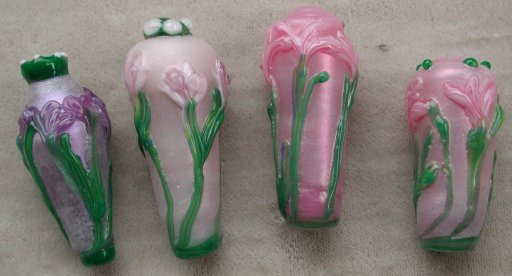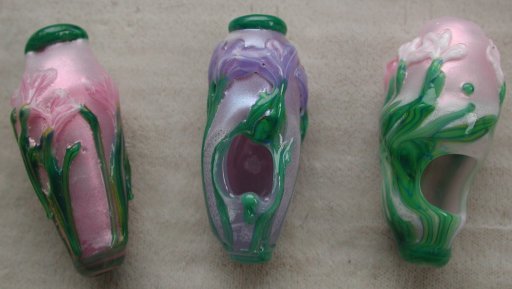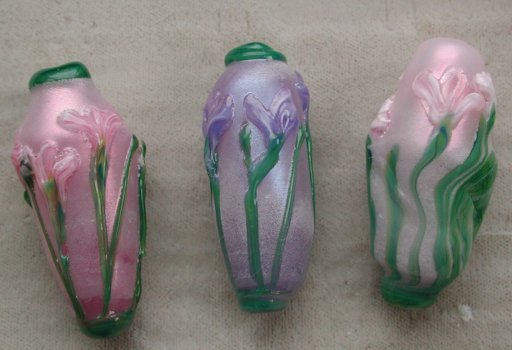There are a couple of advantages of making pixie dust floral vase beads out of lead Satake glass. Satake is a Japanese hand pulled glass, available in a soda lime version with a coe of approximately 113, and a lead version of 120. According to Arrow Springs, they're not to be mixed. According to a demo on satake I saw some years ago at Gathering, if you want red or a dense white in your lead satake beads, you use some of the soda-lime, ’cuz red isn't available in the lead version.

Four satake pixie vase beads. These, if anything, are more saturated in the picture than reality (lately the problem has typically been the other way around.)
I have only the lead version, which, while it doesn't have any red, surely has a beautiful assortment of pinks, purples, greens, yellows and creams. Satake has any other number of good points, but I'll start with what is for me it's biggest downside: my favorite vendor, Arrow Springs, effectively no longer carries it, despite listing it in their catalog. I suspect that, like me, they've simply decided to move on, now that sheet glass manufacturers such as Bullseye has expanded their (rod) line so much and even Spectrum is getting into flameworking act. Thus, they've discontinued the awful Indian PIG, and no doubt list the Satake in hopes of clearing it out as well. But this means if I want to buy more, I have to get it from C&RLoo, and I'm simply too prickly a customer to get along with them well.
Lead glass in general has low viscosity and greater resistance to thermal shock, which makes it ideal for vase beads that take a long time to wind: quite often with soda-lime glasses, by the time I get to one end of a vase, the beginning end (the bottom) has cracked and must be ‘healed’—usually doable, but a pest. Satake is very soft glass, which is both an advantage and disadvantage: on the one hand, the hilite pixie dust burns readily, and I'm less likely to ruin it on satake; on the other hand, I use a lynx, a very hot torch—adjusting it properly for satake is a pest—and so I quite often end up boiling the glass instead. Japanese beadmakers use a air/gas (rather than oxy-gas) style torch that looks an awful lot like a bunsen burner to work this stuff, and personally I preferred working it with a minor.

No. The problems with #2 & #3 are obvious, but if you look carefully at the top of #1, you can see I rested it against the metal rack a little too soon, neatly spearing it with two prongs. Sigh.
The softness is not so much a downside, as is the fact that I'm not used to it (and can't adjust my torch to a wide bushy flame, of course—excuses, excuses.) Needless to say, the bead on the left was particularly frustrating, because it was fine until my lack of judgement as to how stiff it was—that is, throwing it into the kiln too soon—ruined it. Rats!
Or, as they say, live and learn.
Satake lead glass, pixie dust, artist pulled cane (for the flowers, stems and leaves.) Beads are made on 3/32” mandrels, and measure (for example) 21x46mm (pink holed) and 17x46mm (purple holed).
Unless otherwise noted, text, image and objects depicted therein copyright 1996--present sylvus tarn.
Sylvus Tarn